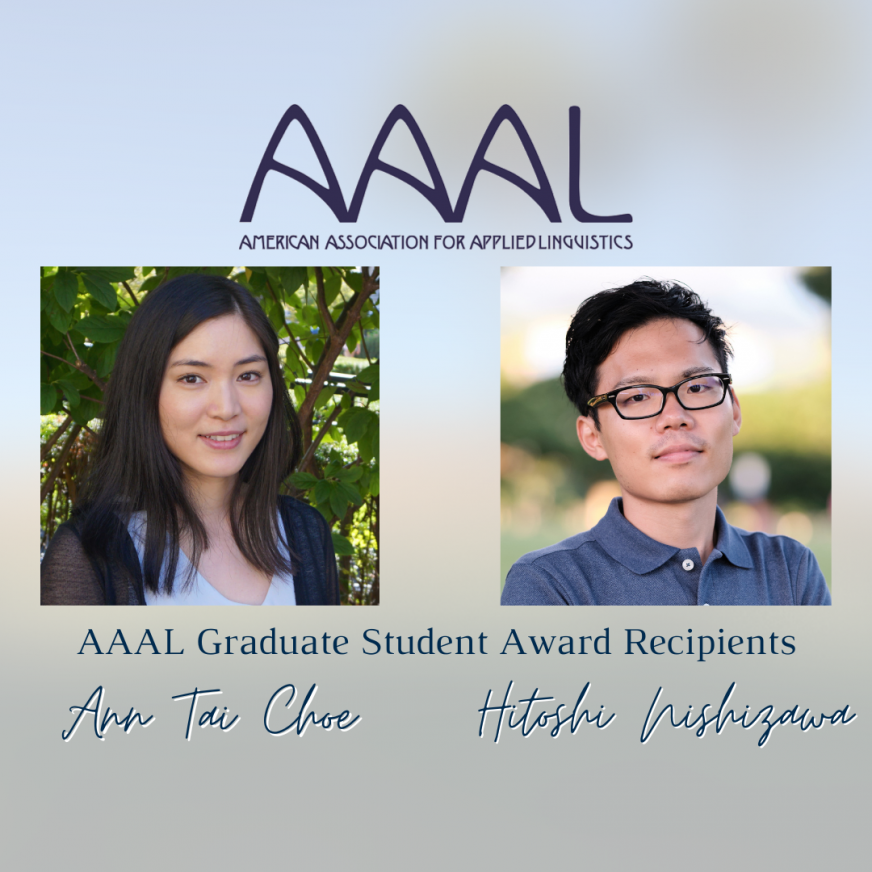
Ph.D. students Ann Tai Choe and Hitoshi Nishizawa have both received AAAL Graduate Student Awards for their presentation proposals. Both students will be practicing their talks on March 9th at the Brown Bag Thursday Lecture Series. Current SLS students, faculty, and staff are invited to watch and give feedback.
AAAL is the leading North American conference for applied linguistics, and the Department of Second Language Studies is well-known for our faculty and student representation.
Ann Tai Choe – A Comparative Analysis of Service-Learners’ Intercorporeal Co-operative Practices in the Classroom and Beyond
While past research has explored service-learning (SL)—an experiential pedagogy that engages students in community-based service activities and reflection on their experiences—in the second language (L2) context (e.g., Poteau, 2020; Wurr & Hellebrandt, 2007), only a few studies have examined participants’ social practices for accomplishing SL in real-time interaction (e.g., Perren, 2007). Furthermore, the nexus between classroom learning and real-world service activities remains underexplored (Overfield, 2007). To inform decisions about L2 education across diverse linguistic and situational contexts, it is important to consider how classroom learning may be linked to out-of-school experiences (e.g., Eskildsen & Majlesi, 2018; Hellermann et al., 2019). This study aims to address this issue by investigating how L2 users achieve SL as a social activity and comparing participants’ practices across different educational settings.
Data come from a larger project that investigates how adult L2 users of English in Hawaiʻi achieve SL as a social activity (approx. 26h of video-recordings). Using multimodal conversation analysis, this study scrutinizes participants’ intercorporeal co-operative practices (Goodwin, 2018; Meyer et al., 2017) in the classroom and beyond. Participants included the L2 users, service agency supervisors, community volunteers, and teachers. Findings revealed that participants frequently employed intercorporeal co-operative actions by producing synchronized or sequentially mirrored actions (Hellermann & Thorne, 2022) during both classroom and service interaction. However, at the service sites (e.g., outdoor fundraising, lantern preparation, letter folding), participants developed and coordinated co-operative actions (e.g., moving and stopping together, bodily transformations) as an activity-specific technique for collaborative task accomplishment, done with or without talk; in contrast, participants in the classroom oriented to achieving intersubjectivity, building affiliation, and invoking humor or shared past experiences via wordplays and reenactment. These findings suggest that SL fosters opportunities for achieving cooperation and intersubjectivity through language and moving bodies across various experiential contexts (Atkinson, 2019).
Hitoshi Nishizawa – Authenticity of listening input: How strong is the shared-L1 effect in more authentic texts?
There is an increasing interest in the authenticity of listening input in language tests. To increase authenticity, scholars advocate the inclusion of L2 accents that represent the sociolinguistic reality of the target language use (TLU) domains (Harding, 2012; Kang et al., 2019). Others have also suggested the use of texts that better reflect the nature of spoken language, including phenomena such as hesitations, false starts, and repetitions (Wagner, 2014). Both approaches have been shown to impact test scores, yet to date, no study has directly compared the effects of each approach nor examined the combination of the two. By investigating the interaction of the two aspects, the present study offers more insight into the relationship between the authenticity of listening input and test scores.
To examine how L2 accent inputs interact with spoken texts, academic lecture texts from IELTS (section 4) were used to create two versions of texts: scripted and authenticated. For the scripted version, original texts were used (Wagner, 2016). For the authenticated texts, texts were rewritten to include spoken language features (Wagner et al., 2021). Audio samples were recorded by an American speaker and a L1 Japanese speaker, who were teaching assistants in the US university. For listeners, Japanese learners of English were recruited to examine the shared-L1 effect.
Data collection is ongoing and a preliminary analysis of 41 listeners (with the planned sample size being 200) found an interaction between accent and scriptedness. The shared-L1 effect was only observed in the scripted texts, but not in the authenticated text. The test score for the authenticated-Japanese text was similar to authenticated-American and scripted-American texts. Building on previous studies, the finding suggests another mediating factor for the shared-L1 effect: scriptedness of the text. Implications for test developers and suggestions for future research will be discussed.